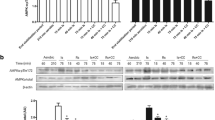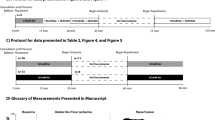Summary
The adenosine triphosphate (ATP) content of isolated Langendorff-perfused rat hearts may be increased by more than 40% above the normal value by a 2-h perfusion with adenosine (15 μmol/l). This metabolic manipulation was used to investigate the hypothetical relationship between total tissue ATP content and ischaemia-induced contractile failure, ischaemic contracture and post-ischaemic functional recovery.
Adenosine perfused hearts were submitted to 20 min of normothermic ischaemia and reperfused for 45 min with or without adenosine. Control experiments were performed with adenosine-free preischaemic perfusion. In identically designed experiments the tissue-protective effect of diltiazem (0.5 μmol/l) was determined and compared with the experiments with adenosine.
At the end of 120 min of preischaemic perfusion, the ATP content of the adenosine treated hearts was 34.3±1.8 μmol/g dry weight (control=23.6±1.9 μmol/g, p<0.01). After a period of 20 min of normothermic ischaemia, the ATP content of the adenosine hearts decreased to 13.3± .4 μmol/g, whereas ATP fell to 8.3±1.6 μmol/g in the control hearts. The creatine phosphate (CP) levels of adenosine hearts were significantly lower than those of the control group before ischaemia, but did not show major differences following ischaemia.
During ischaemia, the contractile activity measured via an intraventricular balloon catheter, as well as ischaemic contracture did not differ between the adenosine and control hearts. The inclusion of diltiazem into the perfusate significantly delayed the onset of contracture.
After 45 min of reperfusion, ATP contents of adenosine and control hearts reached similar values (8.4±2.3 and 8.3±2.9 μmol/g, respectively). Inclusion of adenosine (15 μmol/l in the reperfusion perfusate of the adenosine experiments prevented a further decrease, but did not increase tissue ATP content. CP values of all groups showed a partial recovery upon reperfusion, they did not differ significantly.
Contractile recovery was equal in all experimental groups except for the diltiazem treated hearts, which showed during the first 10 min of reperfusion an improved mechanical performance.
It is concluded that total tissue ATP is not necessarily a good indicator of functional capabilities under conditions of normothermic ischaemia and reperfusion in the isolated rat heart.
Similar content being viewed by others
References
Aussedat J, Rossi A (1977) Conséquences de l'incorpotion d'adenosine sur la vitesse de renouvellement des nucléotides adényliques, dans le cœur isolé et perfusé du lapin. J Physiol (Paris) 73:633–652
Bergmeyer HU (1974) Methoden der enzymatischen Analyse. Verlag Chemie, Weinheim/Bergstraße
Bourdillon PD, Poole-Wilson PA (1980) Effects of verapamil and cardioplegia on calcium exchange and mechanical function in myocardial ischaemia. Circulation 42:31
Bricknell OL, Daries PS, Opie LH (1981) A relationship between adenosine triphosphate, glykolysis and ischaemic contracture in the isolated rat heart. J Mol Cell Cardiol 13:941–945
de Jong JW (1972) Phosphorylation and deamination of adenosine by the isolated, perfused rat heart. Biochim Biophys Acta 286:252–259
Dhalla NS, Tomlinson CW, Singh JN, Lee SL, Mc Namara DB, Harrow JAC, Yates JC (1976) Role of sarcolemmal changes in cardiac pathophysiology. In: Roy PE, Dhalla NS (eds). The sarcolemma: recent advances in studies on cardiac structure and metabolism, Vol. 9. Baltimore, Maryland. University Park Press, pp 377–394
Dow J, Bowditch J, Nigdikar SV, Brown AK (1987) Salvage mechanisms for regeneration of adenosine triphosphate in rat cardiac myocytes. Cardiovasc Res 21:188–196
Drake-Holland AJ, Noble MIM (1983) Myocardial protection by calcium antagonist drugs. Eur Heart J 4:823–825
Ely SW, Mentzer RM, Lasley RD, Lee BK, Berne RM (1985) Functional and metabolic evidence of enhanced myocardial tolerance to ischaemia and reperfusion with adenosine. J. Thorac Cardiovasc Surg 90:549–556
Gadian DG, Radda GK, Brown TR, Chance EM, Dawson MJ, Wilkie DR (1981) The activity of creatine kinase in frog skeletal muscle studied by saturation transfer nuclear magnetic resonance. Biochem J 194:215–228
Ganote CE, Kaltenbach JP (1979) Oxygen-induced enzyme release: early events and a proposed mechanism. J Mol Cell Cardiol 11:389–406
Ganote CE (1983) Contraction band necrosis and irreversible myocardial injury. J Mol Cell Cardiol 15:67–73
Guarnieri C, Flamigni F, Caldarera CM (1980) Role of oxygen in the cellular damage induced by reoxygenation of the hypoxic heart. J Mol Cell Cardiol 12:797–808
Gudbjarnason S, Puri PS, Mathes P (1971) Biochemical changes in non-infarcted heart muscle following myocardial infarction. J Mol Cell Cardiol 2:253–273
Hearse DJ, Garlick PB, Humphrey SM (1977) Ischemic contracture of the myocardium: mechanisms and prevention. Am J Cardiol 39:986–993
Hearse DJ (1979) Oxygen deprivation and early myocardial failure: a reassessment of the possible role of adenosine triphosphate. Am J Cardiol 44:1115–1122
Hoffmeister HM, Mauser M, Schaper W (1985) Effect of adenosine and AICAR on ATP content and regional contractile function on reperfused canine myocardium, Bas Res Cardiol 80:445–458
Hohlfeld Th, Isselhard W (1986) Adenosine: protective action against anoxia in the isolated perfused rat heart. Eur J Physiol, Suppl 406:R 34
Ida T, Ukikusa M, Yamamoto M, Nakase A, Ozawa K, Tobe R (1978) Stimulatory effect of adenosine on hepatic adenine nucleotide and energy charge levels in shocked rats. Circ Shock 5:383–391
Isselhard W, Eitenmüller J, Maurer W, De Vreese A, Reineke H, Czerniak A, Sturz J, Herb HG (1980) Increase of myocardial adenine nucleotides induced by adenosine: dosage, mode of application and duration, species differences. J Mol Cell Cardiol 12:619–634
Jacobus WE, Pores IH, Lucas SK, Weisfeld ML, Flaherty JT (1982) Intracellular acidosis and contractility in the normal and ischemic heart as examined by31PNMR. J Mol Cell Cardiol 14 (suppl. 3):13–20
Jennings RB, Ganote CE, Reimer KA (1975) Ischemic tissue injury. Am J Pathol 81:179–198
Jennings RB, Hawkins HK, Lowe JE, Hill MC, Klottmann S, Reimer KA (1978) Relation between high energy phosphate and lethal injury in myocardial ischemia in the dog. Am J Pathol 92:187–214
Katz AM, Tada M (1977) The “stone heart” and other challenges to the biochemist. Am J Cardiol 39:1073–1077
Klein HH, Schaper J, Puschmann S, Nienaber C, Kreuzer H, Schaper W (1981) Loss of canine myocardial nicotinamide adenine nucleotides determines the transition from reversible to irreversible ischemic damage of myocardial cells. Bas Res Cardiol 76:612–621
Krebs HA, Henseleit K (1932) Untersuchungen über die Harnstoffbildung im Tierkörper. Z Physiol Chem 210:33–66
Kübler W (1967) Nutzbare Ischämiedauer des Herzens in Abhängigkeit von der energetischen Ausgangslage des Myokards, der Kardioplegieform und der Temperatur. Langenbecks Arch Klin Chir 319:648–660
Mauser M, Hoffmeister HM, Nienaber C, Schaper W (1985) Influence of ribose, adenosine and “AICAR” on the rate of myocardial adenine triphosphate synthesis during reperfusion after coronary artery occlusion in the dog. Circ Res 56:220–230
Neely JR, Grotyohann LW (1984) Role of glycolytic products in damage to ischemic myocardium. Circ Res 55:816–824
Nees S, Herzog V, Becker BF, Böck M, Des Rosiers C, Gerlach E (1985) The coronary endothelium: a highly active metabolic barrier for adenosine. Bas Res Cardiol 80:515–529
Reibel DK, Rovetto MJ (1978) Myocardial ATP synthesis and mechanical function following oxygen deficiency. Am J Physiol 234:620–624
Tones MA, Poole-Wilson PA (1983) Effect of lysophosphatidylcholine on cellular integrity and calcium uptake in rabbit myocardium. Eur Heart J 4, Suppl. E:73
Watts JA, Whipple JP, Hatley AA (1987) A low concentration of nisoldipine reduces ischemic injury: enhanced reflow and recovery of contractile function without energy preservation during ischemia. J Mol Cell Cardiol 19:809–817
Wukasch DC, Reul GJ, Milam JD, Hallmann GL, Cooley DA (1972) The “stone heart” syndrome. Surgery 72:1071–1080
Yamamoto F, Manning AS, Braimbridge MV, Hearse DJ (1983) Calcium antanonists and myocardial protection: diltiazem during cardioplegic arrest. Thorac Cardiovasc Surgeon 31:369–373
Zimmer HG, Trendelenburg C, Kammermeier H, Gerlach E (1973) De novo synthesis of myocardial adenine nucleotides in the rat. Circ Res 32:635–642
Zimmermann ANE, Hulsmann WC (1966) Paradoxical influence of calcium ions on the permeability of the cell membrances of the isolated rat heart. Nature 211:646–647
Author information
Authors and Affiliations
Additional information
This work was supported in part by grants from the British heart foundation, the British Council and the St. Thomas, Hospital Research Endowments Fund. The advice and assistance of Dr. M. Curtis and Mrs. C. Erlebach are gratefully acknowledged.
Rights and permissions
About this article
Cite this article
Hohlfeld, T., Hearse, D.J., Yellon, D.M. et al. Adenosine-induced increase in myocardinal ATP: Are there beneficial effects for the ischaemic myocardium?. Basic Res Cardiol 84, 499–509 (1989). https://doi.org/10.1007/BF01908202
Issue Date:
DOI: https://doi.org/10.1007/BF01908202




